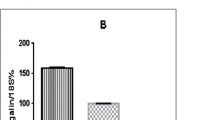Abstract
The transfer of human recombinant erythropoietin (rhEPO) from the maternal to the fetal side was investigated using the technique of in vitro perfusion of an isolated cotyledon of human placenta, with recirculation of the perfusate (130 ml) in separate closed maternal and fetal circuits. rhEPO (221–512 U), together with [14C]BSA (bovine serum albumin, 44.8 kBq or 2,688,000 dpm), was added to the maternal circuit only. Despite a considerably lower molecular weight of EPO mol. wt.=30,400 Da) compared to BSA (mol. wt.= 69,000 Da), no difference was found in their transfer across the placenta from the maternal to the fetal side, which was very low for both macromolecules. The total transfer of rhEPO derived from the concentration measured in the samples taken from the fetal circuit at the end of 4–5 h of perfusion, was in the range of 0.04% of the amount initially added to the maternal compartment. A similar amount of transfer was determined for [14C]BSA (0.04–0.07%,n=12). In conclusion, by direct determination in a dually in vitro perfused human placental cotyledon, no significant transfer of rhEPO from the maternal to the fetal side could be shown.
Similar content being viewed by others
References
Anagnostou A, Lee ES, Kessimian N, Levinson R, Steiner M (1990) Erythropoietin has a mitogenic and positive chemotactic effect on endothelial cells. Proc Natl Acad Sci USA 87: 5978–5982
Bowen D, Ehmer B, Neubert P, Lewis T, Jacobs A (1991) The clearance of a single i.v. bolus of recombinant human erythropoietin from the serum of patients with myelodysplastic syndromes and its effects on erythropoiesis. Exp Hematol 19:613–616
Cotes PM, Canning CE, Lind T (1983) Changes in serum immunoreactive erythropoietin during the menstrual cycle and normal pregnancy. Br J Obstet Gynaecol 90:304–311
Eckardt KU, Kurtz A, Hirth P, Scigalla P, Wieczorek L, Baue C(1988) Evaluation of the stability of human erythropoietin in samples for radioimmunoassay. Klin Wochenschr 66:241–245
Edwards D, Jones CJP, Sibley CP, Nelson DM (1993) Paracellular permeability pathways in the human placenta: a quantitative and morphological study of maternal-fetal transfer of horseradish peroxidase. Placenta 14:63–73
Eichhorn KH, Bauer C, Eckardt KU, Zimmermann R, Huch A, Huch R (1993) Lack of associations between fetal and maternal serum-erythropoietin at birth. Eur J Obstet Gynecol Reprod Biol50:47–52
Flaharty KK, Caro J, Erslev A, Whalen J, Morris EM, Bjornsson TD, Vlasses PH (1990) Pharmacokinetics and erythropoietic response to human recombinant erythropoietin in healthy men. Clin Pharmacol Ther 47:557–564
Gitlin D, Kumate J, Urrusti J, Morales C (1964) The selectivity of the human placenta in the transfer of plasma proteins from mother to fetus. J Clin Invest 43:1938–1951
Hedley R, Bradbury MWB (1980) Transport of polar nonelectrolyts across the intact and perfused guinea-pig placenta. Placenta 1:277–285
Much A, Eichhorn KH, Danko J, Lauener PA, Huch R (1992) Recombinant human erythropoietin in the treatment of postpartum anaemia. Obstet Gynecol 80:127–131
Ireland R, Abbas A, Thilaganathan B, Melbye O, Snjiders R, Layton M, Nicolaides KH (1992) Fetal and maternal erythropoietin levels in normal pregnancy. Fetal Diagn Ther 7:21–25
Jacobson LO, Marks EK, Gaston EO (1959) Studies on erythropoiesis. XII. The effect of transfusion-induced polycythemia in the mother on the fetus. Blood 14:644–653
Jelkmann W (1992) Erythropoietin: structure, control of production and function. Physiol Rev 72:449–489
Koury MJ, Bondurant MC, Graber SE, Sawyer ST (1988) Erythropoietin messenger RNA levels in developing mice and transfer of125I-erythropoietin by the placenta. J Clin Invest 82:154–159
Krantz SB (1991) Erythropoietin. Blood 77:419–434
Macdougall IC, Neubert P, Coles GA, Roberts DE, Dharmasena AD, Williams JD (1989) Pharmacokinetics of recombinant human erythropoietin in patients on continuous ambulatory peritoneal dialysis. Lanccet I: 425–427
Malek A, Sager R, Ugele B, Schneider H (1992) Transport of IgG and its subclasses across the perfused human placenta in vitro. Placenta 13:A42
Masuda S, Nagao M, Takahata K, Konishi Y, Gallyas F Jr, Tabira T, Sasaki R (1993) Functional erythropoietin receptor of the cells with neural characteristics. Comparison with receptor properties of erythroid cells. J Biol Chem 268:11208–11216
Pekonen F, Rosenlöf K, Rutanen EM, Fyhrquist F (1987) Erythropoietin binding sites in human foetal tissues. Acta Endocrinol (Copenh) 116:561–567
Sawada K, Krantz SB, Sawyer ST, Civin CI (1988) Quantitation of specific binding of erythropoietin to human erythroid colony-forming cells. J Cell Physiol 137:337–345
Sawyer ST, Krantz SB, Sawada K (1989) Receptors for erythropoietin in mouse and human erythroid cells and placenta. Blood 74:103–109
Schneider H (1991) The role of the placenta in nutrition of the human fetus. Am J Obstet Gynecol 77:419–434
Schneider H, Panigel M, Dancis J (1972) Transfer across the perfused human placenta of antipyrine, sodium and leucine. Am J Obstet Gynecol 114:822–828
Thomas RM, Canning CE, Cotes PM, Linch DC, Rodeck CH, Rossiter CE, Huehns ER (1983) Erythropoietin and cord blood haemoglobin in the regulation of human fetal erythropoiesis. Br J Obstet Gynaecol 90:795–800
Thorp JA, O'Conner T, Callenbach J, Cohen GR, Yeast JD, Albin J, Plapp F (1991) Hyporegenerative anaemia associated with intrauterine transfusion in rhesus hemolytic disease. Am J Obstet Gynecol 165:79–81
Widness JA, Sawyer ST, Schmidt RL, Chestnut DH (1991) Lack of maternal to fetal transfer of125I-labelled erythropoietin in sheep. J Dev Physiol 15:139–143
Zanjani ED, Peterson EN, Gordon AS, Wasserman LR (1974) Erythropoietin production in the fetus: role of the kidney and maternal anaemia. J Lab Clin Med 83:281–287
Zanjasni ED, Slotnick N, Clemons GK (1990) Erythropoietin does not cross the placenta. Clin Res 38:236A
Author information
Authors and Affiliations
Rights and permissions
About this article
Cite this article
Malek, A., Sager, R., Eckardt, K.U. et al. Lack of transport of erythropoietin across the human placenta as studied by an in vitro perfusion system. Pflügers Arch. 427, 157–161 (1994). https://doi.org/10.1007/BF00585955
Received:
Revised:
Accepted:
Issue Date:
DOI: https://doi.org/10.1007/BF00585955




